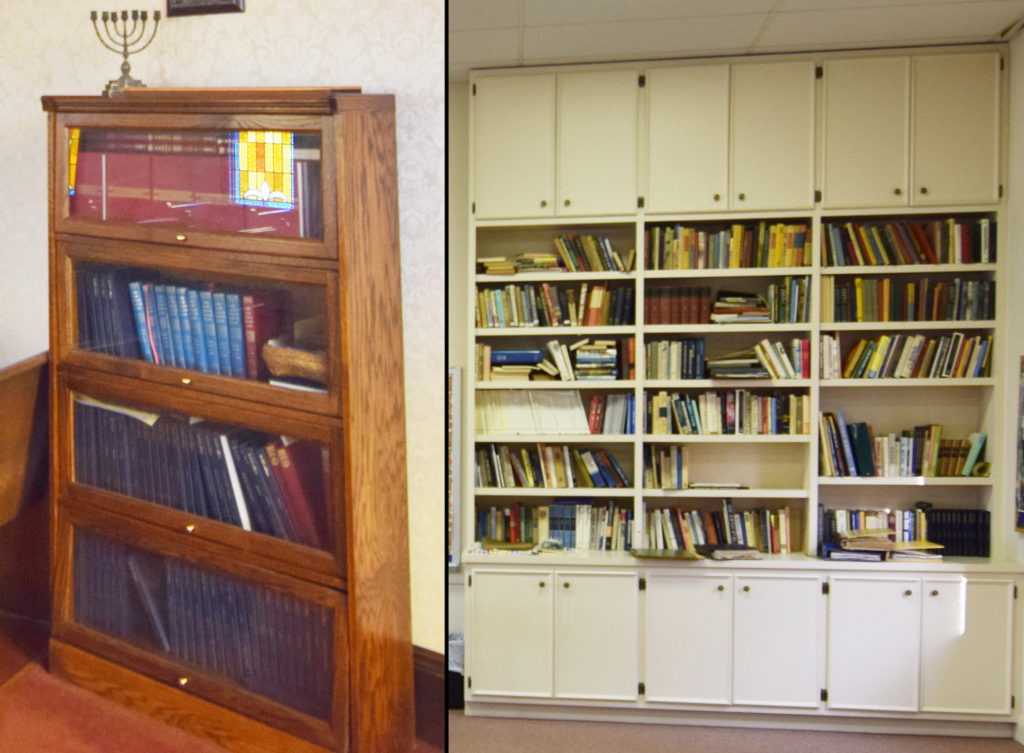Resilience Treatments & Strategies
Books

Description
Collections of bound documents should be housed in a climate-controlled part of your building that is not at risk of flooding. Special collections—books that are particularly rare, fragile, old, or valuable—should be limited in everyday use and access. If culturally significant books need to be regularly used in a part of the building that may be at risk (e.g., hymnals in the backs of pews), they should be stored when not in use in a safe place.
Typical Damages from Floods or Hurricanes
- Books become soaked from floodwater, leaking roof, sprinklers, or ruptured pipes
Other common conditions contributing to vulnerability towards floods or hurricanes
- Lack of emergency, disaster response, or salvage plan
- Environmental controls not being monitored or lack of climate control (HVAC system)
- Material stored in unstable furniture (e.g., wood shelving)
Resilience Treatments and Strategies
The THC offers resources and provides links for more information on salvage and recovery of cultural artifacts [https://www.thc.texas.gov/preserve/projects-and-programs/museum-assistance/additional-resources]
In-house
Inventory collections and develop an emergency plan for the collections, which should include salvage procedures (including the following RTSs) and which books require special treatment.
If books become soaked, remove them from water as soon as possible (and safe to do so—if area is contaminated with sewage or other hazardous materials, contact a professional recovery service immediately). Mold growth can occur in 48 hours and cause irreparable damage.
Choose a salvage technique based on the type and extent of damage. Air drying is often possible in-house, while vacuum freeze-drying or mass dehumidification require professional services. All options, contacts, and steps to carry them out should be in the salvage plan.
- Change furniture to metal shelving or at least place acid- and lignin-free barriers between books and wood surfaces.
- Monitor environmental controls (temperature and relative humidity) to ensure books are optimally stored.
Professional needed [type]
Large collections will need to be dried using a commercial process, such as vacuum freeze-drying or commercial-scale dehumidification [conservation professional].
Install an HVAC system (see Building Services section above) [architect and engineer].
Modify water-based fire suppression system to a low-flow mist system or change/newly install a non-water-based system (e.g., gaseous agent) [architect and engineer].
Books

Description
Collections of bound documents should be housed in a climate-controlled part of your building that is not at risk of flooding. Special collections—books that are particularly rare, fragile, old, or valuable—should be limited in everyday use and access. If culturally significant books need to be regularly used in a part of the building that may be at risk (e.g., hymnals in the backs of pews), they should be stored when not in use in a safe place.
Typical Damages from Floods or Hurricanes
- Books become soaked from floodwater, leaking roof, sprinklers, or ruptured pipes
Other common conditions contributing to vulnerability towards floods or hurricanes
- Lack of emergency, disaster response, or salvage plan
- Environmental controls not being monitored or lack of climate control (HVAC system)
- Material stored in unstable furniture (e.g., wood shelving)
Resilience Treatments and Strategies
The THC offers resources and provides links for more information on salvage and recovery of cultural artifacts [https://www.thc.texas.gov/preserve/projects-and-programs/museum-assistance/additional-resources]
In-house
Inventory collections and develop an emergency plan for the collections, which should include salvage procedures (including the following RTSs) and which books require special treatment.
If books become soaked, remove them from water as soon as possible (and safe to do so—if area is contaminated with sewage or other hazardous materials, contact a professional recovery service immediately). Mold growth can occur in 48 hours and cause irreparable damage.
Choose a salvage technique based on the type and extent of damage. Air drying is often possible in-house, while vacuum freeze-drying or mass dehumidification require professional services. All options, contacts, and steps to carry them out should be in the salvage plan.
- Change furniture to metal shelving or at least place acid- and lignin-free barriers between books and wood surfaces.
- Monitor environmental controls (temperature and relative humidity) to ensure books are optimally stored.
Professional needed [type]
Large collections will need to be dried using a commercial process, such as vacuum freeze-drying or commercial-scale dehumidification [conservation professional].
Install an HVAC system (see Building Services section above) [architect and engineer].
Modify water-based fire suppression system to a low-flow mist system or change/newly install a non-water-based system (e.g., gaseous agent) [architect and engineer].